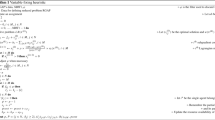Abstract
We consider \(N\)-fold \(4\)-block decomposable integer programs, which simultaneously generalize \(N\)-fold integer programs and two-stage stochastic integer programs with \(N\) scenarios. In previous work (Hemmecke et al. in Integer programming and combinatorial optimization. Springer, Berlin, 2010), it was proved that for fixed blocks but variable \(N\), these integer programs are polynomial-time solvable for any linear objective. We extend this result to the minimization of separable convex objective functions. Our algorithm combines Graver basis techniques with a proximity result (Hochbaum and Shanthikumar in J. ACM 37:843–862,1990), which allows us to use convex continuous optimization as a subroutine.

Similar content being viewed by others
References
De Loera, J.A., Hemmecke, R., Onn, S., Rothblum, U.G., Weismantel, R.: Convex integer maximization via Graver bases. J. Pure Appl. Algebra 213, 1569–1577 (2009)
De Loera, J.A., Hemmecke, R., Onn, S., Weismantel, R.: $N$-fold integer programming. Discret. Optim. 5(2), 231–241 (2008) doi:10.1016/j.disopt.2006.06.006 (In Memory of George B. Dantzig)
Diaconis, P., Graham, R. L., Sturmfels, B.: Primitive partition identities. In: Miklós, D., Sós, V.T., Szőnyi, D. (eds.), Combinatorics, Paul Erdős is Eighty, Volume 2. Bolyai Society Mathematical Studies, vol. 2, pp. 173–192 (1996)
Gollmer, R., Gotzes, U., Schultz, R.: A note on second-order stochastic dominance constraints induced by mixed-integer linear recourse. Math. Program. 126, 179–190 (2011)
Graver, J.E.: On the foundations of linear and integer linear programming I. Math. Program. 8, 207–226 (1975)
Hemmecke, R.: Test sets for integer programs with $\mathbb{Z}$-convex objective. eprint arXiv:math/0309154 (2003)
Hemmecke, R.: On the positive sum property and the computation of Graver test sets. Math. Program. Ser. B 96, 247–269 (2003)
Hemmecke, R., Köppe, M., Weismantel, R.: A polynomial-time algorithm for optimizing over \(N\)-fold 4-block decomposable integer programs, In: Eisenbrand, F., Shepherd, F.B. (eds.), Integer Programming and Combinatorial Optimization. Lecture Notes in Computer Science, vol. 6080, Springer, Berlin, pp. 219–229 (2010). doi:10.1007/978-3-642-13036-6_17
Hemmecke, R., Onn, S., Romanchuk, L.: $N$-fold integer programming in cubic time. Math. Program. 1–17 (2011). doi:10.1007/s10107-011-0490-y
Hemmecke, R., Onn, S., Weismantel, R.: A polynomial oracle-time algorithm for convex integer minimization. Math. Program. 126, 97–117 (2011). doi:10.1007/s10107-009-0276-7
Hemmecke, R., Schultz, R.: Decomposition of test sets in stochastic integer programming. Math. Program. 94(2–3), 323–341 (2003)
Hochbaum, D.S.: Lower and upper bounds for allocation problems. Math. Oper. Res. 19, 390–409 (1994)
Hochbaum, D.S., Shanthikumar, J.G.: Convex separable optimization is not much harder than linear optimization, J. ACM 37, 843–862 (1990). doi:10.1145/96559.96597
Minoux, M.: Solving integer minimum cost flows with separable convex cost objective polynomially. Math. Prog. Study 26, 237–239 (1986)
Mirchandani, P., Soroush, H.: The stochastic multicommodity flow problem. Networks 20, 121–155 (1990)
Murota, K., Saito, H., Weismantel, R.: Optimality criterion for a class of nonlinear integer programs. Oper. Res. Lett. 32, 468–472 (2004)
Onn, S.: Nonlinear Discrete Optimization. Zurich Lectures in Advanced Mathematics, European Mathematical Society (2010)
Onn, S.: Theory and applications of $N$-fold integer programming. In: The IMA Volumes in Mathematics and its Applications, Mixed Integer Nonlinear Programming, pp. 559–593. Springer, Berlin (2012)
Onn, S., Rothblum, U.G.: Convex combinatorial optimization. Disc. Comp. Geom. 32, 549–566 (2004)
Powell, W., Topaloglu, H.: Dynamic-programming approximations for stochastic time-staged integer multicommodity-flow problems. INFORMS J. Comput. 18, 31–42 (2006)
Schrijver, A.: Theory of Linear and Integer Programming. Wiley, New York (1986)
Schulz, A.S., Weismantel, R.: An oracle-polynomial time augmentation algorithm for integer programming. In: Proceedings of the 10th Annual ACM-SIAM Symposium on Discrete Algorithms, pp. 967–968 (1999)
Schulz, A.S., Weismantel, R., Ziegler, G.M.: 0/1 integer programming: optimization and augmentation are equivalent. In: Spirakis, P. (ed.), Algorithms-ESA 95, Lecture Notes in Computer Science, vol. 979, Springer, Berlin, pp. 473–483 (1995)
Seymour, P.D.: Decomposition of regular matroids. J. Comb. Theory 28, 305–359 (1980)
Acknowledgments
We wish to thank Rüdiger Schultz for valuable comments and for pointing us to [4]. We also would like to thank Shmuel Onn for pointing us toward the paper by Hochbaum and Shanthikumar. The second author was supported by grant DMS-0914873 of the National Science Foundation. The third author was partially supported by the German Science Foundation, grant SFB/Transregio 63 InPROMPT. A part of this work was completed during a stay of the three authors at BIRS.
Author information
Authors and Affiliations
Corresponding author
Additional information
We dedicate this paper to the memory of Uri Rothblum. His paper [19] has been an inspiration for our work on nonlinear discrete optimization. As a coauthor of R.H. and R.W. in [1], Uri contributed to the application of Graver basis techniques for block-structured problems. We believe that the present paper continues the theme of research at the interface of algebra, geometry, combinatorics, and optimization that Uri appreciated.
Rights and permissions
About this article
Cite this article
Hemmecke, R., Köppe, M. & Weismantel, R. Graver basis and proximity techniques for block-structured separable convex integer minimization problems. Math. Program. 145, 1–18 (2014). https://doi.org/10.1007/s10107-013-0638-z
Received:
Accepted:
Published:
Issue Date:
DOI: https://doi.org/10.1007/s10107-013-0638-z
Keywords
- \(N\)-fold integer programs
- Graver basis
- Augmentation algorithm
- Proximity
- Polynomial-time algorithm
- Stochastic multi-commodity flow
- Stochastic integer programming




